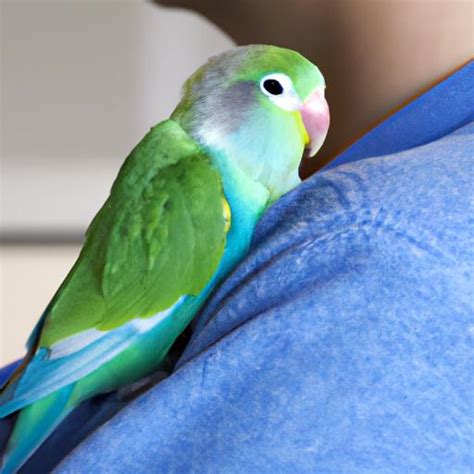Introduction
Parrotlets are small, adorable parrots that are quickly gaining popularity as beloved companions. With their vibrant colors and charming personalities, these tiny birds offer a wealth of joy and companionship. However, like any pet, they require proper care and attention to thrive. This comprehensive guide will provide you with everything you need to know about parrotlet care and behavior in 2025, ensuring you have a happy and healthy feathered friend for years to come.

Understanding Parrotlets
Origin and Appearance
Parrotlets are native to Central and South America, primarily found in Venezuela, Columbia, and Ecuador. They belong to the Psittaculidae family and are characterized by their small size, averaging around 4-6 inches in length. Their plumage exhibits stunning variations, including shades of green, blue, yellow, and violet, making them visually captivating.
Temperament and Personality
Parrotlets are known for their playful and energetic nature. They are highly intelligent and curious, making them excellent companions for interactive play and training. They are generally affectionate and loyal, forming strong bonds with their owners. However, they can also be territorial and noisy at times, requiring patience and understanding.
Lifespan and Health
With proper care and nutrition, parrotlets can have a lifespan of 15-20 years. They are generally hardy birds but can be prone to certain health issues, including respiratory problems and feather plucking. Regular veterinary checkups and proper hygiene are essential for maintaining their well-being.
Essential Care for Parrotlets
Housing and Environment
Parrotlets require a spacious cage or aviary that provides ample room for flight and play. The enclosure should be equipped with perches of various sizes and textures, toys, and a nesting box. They prefer warm and humid environments, so maintaining a temperature of around 75-80 degrees Fahrenheit is ideal.
Nutrition
A balanced diet is crucial for parrotlets’ health. Their diet should primarily consist of high-quality pellets, supplemented with fresh fruits, vegetables, and a small amount of seeds. Avoid giving them sugary foods or avocado, as these can be harmful.
Hygiene and Grooming
Regular bathing is essential for parrotlets’ hygiene. Misting them with lukewarm water a few times a week or providing a shallow water dish for bathing can help keep their feathers clean and healthy. Their beaks and nails should also be trimmed regularly to prevent overgrowth.
Socialization and Training
Parrotlets are social creatures and require regular interaction to remain happy and well-adjusted. Spend time with them daily for play, petting, and training. They are capable of learning tricks and commands, which can provide both mental stimulation and entertainment.
Understanding Parrotlet Behavior
Vocalizations
Parrotlets are known for their distinctive vocalizations, ranging from cheerful chirps to loud squawks. They use these vocalizations to communicate their moods, intentions, and needs. While they are not known for mimicry like other parrots, they can sometimes learn to repeat certain words or phrases.
Body Language
Parrotlets communicate their feelings through their body language as well. A relaxed and contented parrotlet will have its feathers fluffed out, its head tucked under its wing, and its eyes closed. Conversely, a stressed or aggressive parrotlet may exhibit puffed-up feathers, a raised crest, and dilated pupils. Understanding their body language can help you interpret their needs and respond appropriately.
Common Behavioral Issues
Like any other pet, parrotlets can develop certain behavioral issues, such as feather plucking, screaming, or aggression. These behaviors often stem from stress, boredom, or lack of attention. Addressing the underlying cause and providing appropriate solutions is crucial for resolving these issues.
Current Status and Future Trends
The popularity of parrotlets as companion birds is steadily growing, and this trend is expected to continue in 2025 and beyond. Breeders are developing new color mutations and variations, expanding the available options for enthusiasts. Advances in veterinary care and nutrition are also contributing to the overall well-being and longevity of parrotlets.
Conclusion
Parrotlets are delightful and rewarding companions that bring joy and laughter into our lives. By providing them with optimal care and understanding their behavior, we can ensure they thrive and enrich our lives for years to come. Remember, the bond between you and your parrotlet is unique and should be cherished. Embrace the challenges and joys of parrotlet ownership, and you will be rewarded with a lifelong companion that will fill your heart with immeasurable love and happiness.
| Age | Weight (grams) | Length (cm) |
|---|---|---|
| 0-6 months | 20-30 | 10-12 |
| 6-12 months | 30-40 | 12-14 |
| 12-18 months | 40-50 | 14-16 |
| 18+ months | 50-60 | 16-18 |
| Food | Amount | Frequency |
|---|---|---|
| Pellets | 1/4 cup | Daily |
| Fresh fruits | 1/8 cup | 2-3 times per week |
| Fresh vegetables | 1/8 cup | 2-3 times per week |
| Seeds | 1/8 cup | 1-2 times per month |
| Behavior | Cause | Solution |
|---|---|---|
| Feather plucking | Stress, boredom | Provide more toys, interaction, and a larger cage |
| Screaming | Attention-seeking, loneliness | Spend more time with your parrotlet, provide interactive toys |
| Aggression | Territoriality, fear | Identify triggers and avoid them, socialize your parrotlet gradually |
| Health Issue | Symptoms | Treatment |
|---|---|---|
| Respiratory infection | Difficulty breathing, sneezing | Antibiotics |
| Feather plucking | Removal of feathers | Behavioral therapy, addressing underlying stress |
| Proventricular dilatation disease (PDD) | Vomiting, weight loss | No cure, supportive care |





















